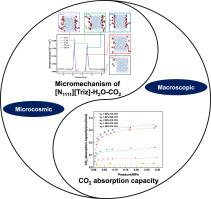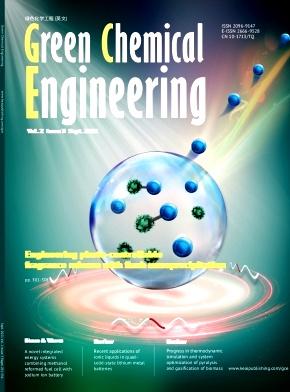A multiscale investigation combining thermodynamic modeling and molecular dynamics study on CO2 capture with [N1111][Triz]-H2O solvent
IF 7.6
Q1 ENGINEERING, CHEMICAL
引用次数: 0
Abstract
The urgent need to mitigate anthropogenic CO2 emissions has driven the development of energy-efficient carbon capture systems. This study investigated a [N1111][Triz]-H2O hybrid solvent for CO2 capture using integrated experimental and computational approaches. A multiscale methodology combining thermodynamic analysis, phase equilibrium measurements, and molecular dynamics (MD) simulations was employed to elucidate the absorption mechanisms and the composition-property relationships. The thermodynamic analysis, incorporating Henry's law, the non-random two-liquid (NRTL) model for activity coefficients, the Redlich-Kwong equation, and reaction equilibrium constraints, accurately predicted the gas-liquid equilibrium (GLE) behavior, achieving an R2 of 99.1% and an average absolute relative deviation (AARD) of 7.76%. The [N1111][Triz]-H2O hybrid solvent exhibits exceptional CO2 absorption performance, with a capacity of 0.25 mol/mol (at 313.15 K and 0.025 MPa for wIL = 80%), attributed to synergistic physical-chemical interactions. MD simulations reveal the dynamic CO2 absorption process in [N1111][Triz]-H2O hybrid solvents: CO2 molecules preferentially accumulate at the gas-liquid interface before gradually diffusing into the bulk phase. Increasing the [N1111][Triz] content enhances CO2 absorption capacity by providing more interaction sites, while water modulates interfacial behavior and diffusion kinetics. This research provides in-depth insights into the absorption behaviors of [N1111][Triz]-H2O hybrid solvents for CO2, offering theoretical support for the development of efficient CO2 capture solvents and highlighting its potential for industrial implementation.

[N1111][Triz]-H2O溶剂捕集CO2的热力学模型与分子动力学研究
减少人为二氧化碳排放的迫切需要推动了节能碳捕获系统的发展。本研究采用实验与计算相结合的方法研究了[N1111][Triz]-H2O混合溶剂对CO2的捕集效果。采用热力学分析、相平衡测量和分子动力学(MD)模拟相结合的多尺度方法来阐明吸收机理和组成-性质关系。热力学分析结合亨利定律、活度系数非随机双液(NRTL)模型、Redlich-Kwong方程和反应平衡约束,准确预测了气液平衡(GLE)行为,R2为99.1%,平均绝对相对偏差(AARD)为7.76%。[N1111][Triz]-H2O混合溶剂表现出优异的CO2吸收性能,在313.15 K和0.025 MPa (wIL = 80%)条件下,由于物理化学相互作用的协同作用,其CO2吸收容量为0.25 mol/mol。MD模拟揭示了CO2在[N1111][Triz]-H2O混合溶剂中的动态吸收过程:CO2分子优先在气液界面积聚,然后逐渐扩散到体相。增加[N1111][Triz]含量通过提供更多的相互作用位点来提高CO2的吸收能力,而水调节界面行为和扩散动力学。本研究深入了解了[N1111][Triz]-H2O混合溶剂对CO2的吸收行为,为开发高效的CO2捕集溶剂提供了理论支持,并突出了其工业应用潜力。
本文章由计算机程序翻译,如有差异,请以英文原文为准。
求助全文
约1分钟内获得全文
求助全文
来源期刊

Green Chemical Engineering
Process Chemistry and Technology, Catalysis, Filtration and Separation
CiteScore
11.60
自引率
0.00%
发文量
58
审稿时长
51 days
 求助内容:
求助内容: 应助结果提醒方式:
应助结果提醒方式:


